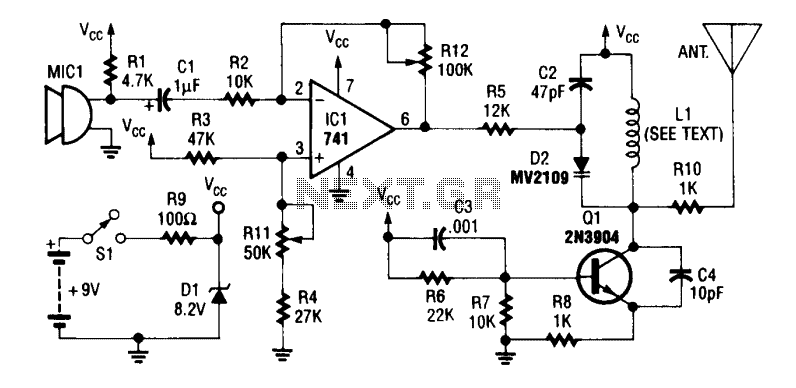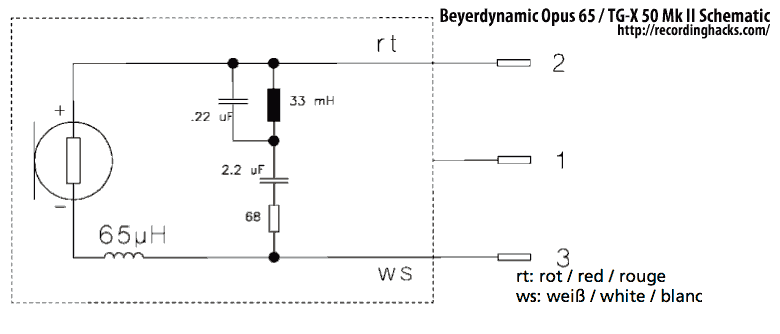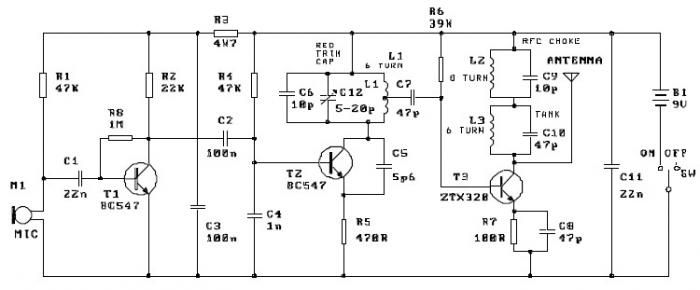
FM transmitter microphone

An operational amplifier integrated circuit (741) amplifies the audio signal from microphone MIC1, with resistor R12 adjusting its gain. The amplified audio is directed to the oscillator circuit, which includes transistor Q1 and associated components. D2 is a varactor diode, and the audio signal applied to D2 modulates the frequency of the oscillator signal. Additionally, L1 consists of three turns of #18 gauge wire, and the antenna is a 12-inch whip.
The circuit utilizes the operational amplifier (op-amp) 741, which is a versatile device commonly used in audio applications due to its high gain and low noise characteristics. The microphone (MIC1) captures audio signals, which are then sent to the op-amp for amplification. The gain of the op-amp is set by resistor R12, allowing for customization based on the required output level.
The amplified audio signal is then fed into an oscillator circuit, which is primarily composed of transistor Q1. This transistor is responsible for generating a carrier frequency that can be modulated. The modulation process is accomplished using D2, the varactor diode, which changes its capacitance based on the input audio signal. This change in capacitance alters the frequency of the oscillator, resulting in frequency modulation (FM) of the output signal.
Inductor L1, constructed with three turns of #18 gauge wire, plays a crucial role in the oscillator circuit by providing the necessary inductance to work in conjunction with the varactor diode. The choice of wire gauge and the number of turns are critical for achieving the desired inductance value, which impacts the overall performance of the oscillator.
The antenna, designed as a 12-inch whip, is used to transmit the modulated signal. The length of the antenna is selected to optimize transmission efficiency at the operating frequency, ensuring that the signal can be effectively radiated into the surrounding environment. Overall, this circuit design is suitable for applications requiring audio transmission via frequency modulation, providing a compact and efficient solution for wireless audio communication.An op-amp IC (741) amplifies the audio signal from MIC1, and R12 controls its gain. Audio is fed to the oscillator circuit Q1 and related components. D2 is a varactor diode. Audio fed to D2 causes FM of the oscillator signal. L1 is 3 turns of #18 wire. The antenna is a 12" whip.
The circuit utilizes the operational amplifier (op-amp) 741, which is a versatile device commonly used in audio applications due to its high gain and low noise characteristics. The microphone (MIC1) captures audio signals, which are then sent to the op-amp for amplification. The gain of the op-amp is set by resistor R12, allowing for customization based on the required output level.
The amplified audio signal is then fed into an oscillator circuit, which is primarily composed of transistor Q1. This transistor is responsible for generating a carrier frequency that can be modulated. The modulation process is accomplished using D2, the varactor diode, which changes its capacitance based on the input audio signal. This change in capacitance alters the frequency of the oscillator, resulting in frequency modulation (FM) of the output signal.
Inductor L1, constructed with three turns of #18 gauge wire, plays a crucial role in the oscillator circuit by providing the necessary inductance to work in conjunction with the varactor diode. The choice of wire gauge and the number of turns are critical for achieving the desired inductance value, which impacts the overall performance of the oscillator.
The antenna, designed as a 12-inch whip, is used to transmit the modulated signal. The length of the antenna is selected to optimize transmission efficiency at the operating frequency, ensuring that the signal can be effectively radiated into the surrounding environment. Overall, this circuit design is suitable for applications requiring audio transmission via frequency modulation, providing a compact and efficient solution for wireless audio communication.An op-amp IC (741) amplifies the audio signal from MIC1, and R12 controls its gain. Audio is fed to the oscillator circuit Q1 and related components. D2 is a varactor diode. Audio fed to D2 causes FM of the oscillator signal. L1 is 3 turns of #18 wire. The antenna is a 12" whip.





